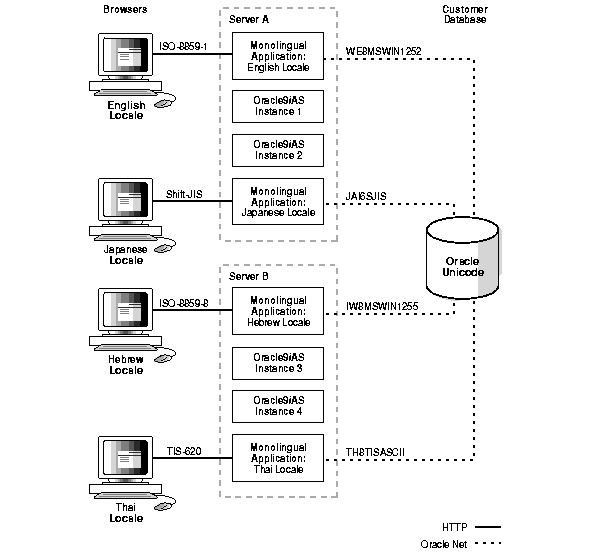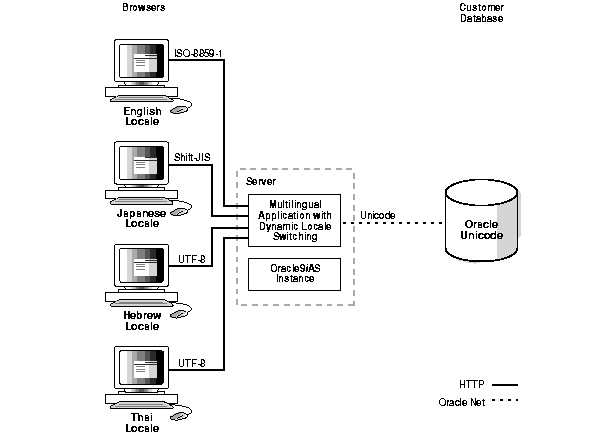Release 2 (9.0.2)
Part Number A92110-02
Home |
Solution Area |
Contents |
Index |
| Oracle9i Application Server Globalization Support Guide Release 2 (9.0.2) Part Number A92110-02 |
|
This chapter contains the following topics:
It is increasingly important for businesses to make their Internet applications available with appropriate locale characteristics, such as language and currency formats, to users around the world. The Oracle9i Application Server (Oracle9iAS) is fully internationalized to provide a global platform for developing and deploying Internet applications.
Building an Internet application or Web site for Oracle9iAS requires good globalization practices in development and deployment. This book describes recommended globalization practices.
Chapter 4 contains information about a multilingual demo that is included with Oracle9iAS.
You need to be familiar with the following concepts to understand the rest of this book:
Locale refers to a language, a character set, and the region (territory) in which the language is spoken. Information about the region includes formats for dates and currency, for example. The primary languages of the United States and Great Britain are both forms of English, but the two territories have different currencies and different conventions for date formats. Therefore, the United States and Great Britain are different locales.
A character set defines the binary values that are associated with the characters that make up a language. For example, the ISO-8859-1 character set can be used to encode most Western European languages.
Unicode is a universal character set that defines binary values for characters in almost all languages. Unicode characters can be encoded as follows:
There are several approaches to designing global Internet applications. This book discusses two approaches: monolingual and multilingual.
You can design a monolingual Internet application so that it supports several instances. Each instance supports a different locale. Users with different locale preferences must invoke the instance that serves their locale.
You can design a multilingual Internet application to support several locales with one instance. All users, regardless of locale, can invoke the same instance.
Both designs include one centralized database that uses a Unicode character set.
This section contains the following topics:
Figure 1-1 shows the design of a monolingual Internet application.

The clients (in English, Japanese, Hebrew, and Thai locales) communicate with separate instances of Oracle9iAS through HTTP connections. One instance of the application runs in the same locale as one of the Oracle9iAS instances. For example, the English application runs in the same locale as Oracle9iAS Instance 1. The English and Japanese applications and their Oracle9iAS instances are running on Server A, and the Hebrew and Thai applications and their instances are running on Server B. Each Oracle9iAS instance communicates with the Unicode database. The instances communicate with the database through Oracle Net.
The client character set for the English locale, for example, is ISO-8859-1. The instance of Oracle9iAS that is associated with the English locale, Instance 1, uses the Oracle character set WE8MSWIN1252 to communicate with the database. The database character set is a Unicode character set.
Table 1-1 shows the advantages and disadvantages of deploying monolingual Internet applications. As the number of locales increases, the disadvantages outweigh the advantages of the monolingual design. This type of application design is suitable for customers who support only one or two locales.
Figure 1-2 shows the design of a multilingual Internet application.

The clients (in English, Japanese, Hebrew, and Thai locales) communicate with one Oracle9iAS instance through HTTP connections. Each client can use a different character set because Oracle9iAS is configured to support several locales simultaneously. The Oracle9iAS instance and the database communicate through Oracle Net. Both the Oracle9iAS instance and the database use Unicode character sets. The Unicode character sets do not have to be the same.
In order to support several locales in a single application instance, an application should:
Table 1-2 shows the advantages and disadvantages of deploying multilingual Internet applications.
A centralized Unicode database is a feature of both the monolingual approach and the multilingual approach to developing globalized Internet applications. Using a centralized database has the following advantages:
The database character set should be Unicode. You can use Unicode to store and manipulate data in several languages. Unicode is a universal character set that defines characters in almost all languages in the world. Oracle9i databases can store Unicode data in one of the following encoding forms:
See Also:
|
|
 Copyright © 2002 Oracle Corporation. All Rights Reserved. |
|